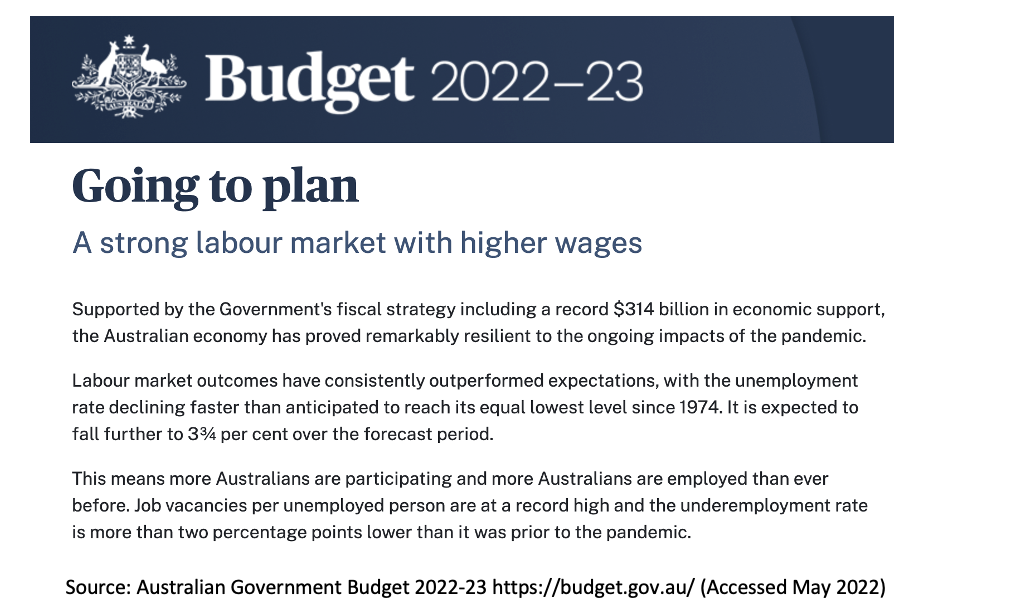Now that you have developed an understanding of the policy tools that are available to address economic challenges, your task is to prepare material that will go towards a Policy Brief analysing Australia’s economic recovery from the COVID pandemic and building an equitable and resilient economy in the future. Imagine you are now employed as a Graduate Economist working for the Australian Treasury. Your team is responsible for putting together a Policy Brief for the department that summarises some key aspects of the government’s policy responses to the COVID-19 recession and provides policy analysis to strengthen Australia’s economy in the future. You have a very important job! Your task is to provide clear answers to the following queries that have been requested from your department manager, using the knowledge and skills that you have gained from your macroeconomics course. c. In last year’s Budget (2022-23), the previous Australian Treasurer Josh Frydenberg announced that the Australian Government had injected $314 billion in economic support to assist the Australian economy to recover from the recessionary impacts of the pandemic. See the former Treasurer’s Statement below. Your job is to calculate the overall impact of the government’s $314 billion stimulus package on the economy. To do this, you will need to calculate the numerical value of the fiscal policy multiplier. You have information indicating that Australians pay an average rate of 23% of their income on taxes, and spend about 16% of their household income on imports. To figure out the other information needed to calculate the multiplier, you should use the ABS data from the previous question on the household saving ratio. You should use the saving ratio that corresponds to the period that the stimulus package was injected into the economy, which roughly corresponds to the first 12 months of the pandemic. Your colleague suggests that, to figure out the saving ratio to insert to the multiplier formula, you should compute the average saving ratio for the following quarters: June 2020, Sep 2020, Dec 2020 and March 2021. You agree this is a logical approach. When writing your Policy Brief, your manager has asked you to provide the formula for the fiscal multiplier and the full steps of your working to show how you arrived at your answer as part of good professional practice. When you present your final answer, write a clear sentence explaining how to interpret this final number. Tip: The convention in your department is to round off all figures to 2 decimal points. This means that you should keep 2 decimal points in your answers for all steps of these calculations (that is, when you compute average saving ratio for the four quarters, when you compute the value of the multiplier, and when you compute the overall impact of the stimulus package on GDP).
Now that you have developed an understanding of the policy tools that are available to address economic challenges, your task is to prepare material that will go towards a Policy Brief analysing Australia’s economic recovery from the COVID pandemic and building an equitable and resilient economy in the future.
Imagine you are now employed as a Graduate Economist working for the Australian Treasury. Your team is responsible for putting together a Policy Brief for the department that summarises some key aspects of the government’s policy responses to the COVID-19 recession and provides policy analysis to strengthen Australia’s economy in the future. You have a very important job!
Your task is to provide clear answers to the following queries that have been requested from your department manager, using the knowledge and skills that you have gained from your
c. In last year’s Budget (2022-23), the previous Australian Treasurer Josh Frydenberg announced that the Australian Government had injected $314 billion in economic support to assist the Australian economy to recover from the recessionary impacts of the pandemic. See the former Treasurer’s Statement below.
Your job is to calculate the overall impact of the government’s $314 billion stimulus package on the economy.
To do this, you will need to calculate the numerical value of the fiscal policy multiplier. You have information indicating that Australians pay an average rate of 23% of their income on taxes, and spend about 16% of their household income on imports. To figure out the other information needed to calculate the multiplier, you should use the ABS data from the previous question on the household saving ratio. You should use the saving ratio that corresponds to the period that the stimulus package was injected into the economy, which roughly corresponds to the first 12 months of the pandemic. Your colleague suggests that, to figure out the saving ratio to insert to the multiplier formula, you should compute the average saving ratio for the following quarters: June 2020, Sep 2020, Dec 2020 and March 2021. You agree this is a logical approach.
When writing your Policy Brief, your manager has asked you to provide the formula for the fiscal multiplier and the full steps of your working to show how you arrived at your answer as part of good professional practice.
When you present your final answer, write a clear sentence explaining how to interpret this final number.
Tip: The convention in your department is to round off all figures to 2 decimal points. This means that you should keep 2 decimal points in your answers for all steps of these calculations (that is, when you compute average saving ratio for the four quarters, when you compute the value of the multiplier, and when you compute the overall impact of the stimulus package on GDP).

Trending now
This is a popular solution!
Step by step
Solved in 3 steps




